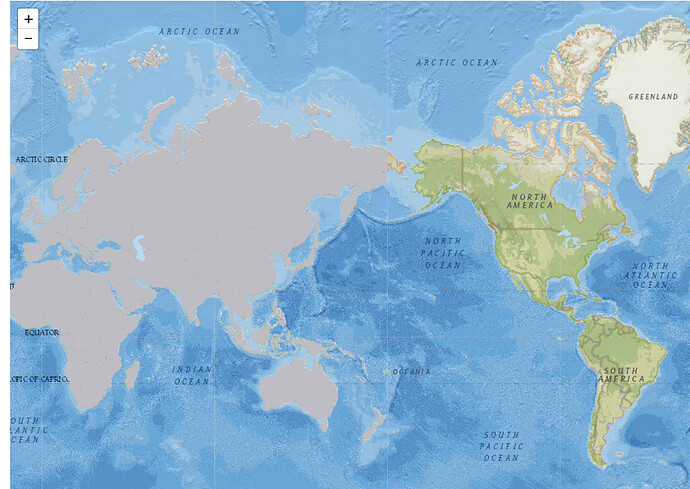Cannot fix my problem for MULTIPLE filters/polygons. Currently my code works, but very slow, I do not use observe(), reactive(), and LeafletProxy(), because I stumbled.
I obviously checked this SO answer Changing Leaflet map according to input without redrawing and this one Making Shiny UI Adjustments Without Redrawing Leaflet Maps and leaflet tutorial Using Leaflet with Shiny.
In my case I have four filters and do not quite understand how to combine them together and make the map fast.
My sample data:
Country Client Channel Status
Country 1 Client 1 Agent network Launched
Country 2 Client 2 Debit cards Launched
Country 3 Client 3 M-banking Planning
Country 4 Client 4 M-banking Launched
Country 5 Client 5 Agent network Launched
Country 6 Client 6 Agent network Launched
Country 7 Client 7 Agent network Pilot
This code works, but slowly, the map is heavy, it causes shadow on a leaflet map
# Packages
library(shiny)
library(shinythemes)
library(leaflet)
library(rgdal)
# Set working directory
setwd("C: /My Shiny apps")
# Read csv, which was created specifically for this app
projects <- read.csv("sample data10.csv", header = TRUE)
# Read a shapefile
countries <- readOGR(".","ne_50m_admin_0_countries")
# Merge data
projects.df <- merge(countries, projects, by.x = "name", by.y = "Country")
class(projects.df)
# Shiny code
# UI
ui <- fluidPage(theme = shinytheme("united"),
titlePanel("Map sample)"),
sidebarLayout(
sidebarPanel(
selectInput("countryInput", "Country",
choices = c("Choose country", "Country 1",
"Country 2",
"Country 3",
"Country 4",
"Country 5",
"Country 6",
"Country 7"),
selected = "Choose country"),
selectInput("clientInput", " Client",
choices = c("Choose Client", "Client 1",
"Client 2",
"Client 3",
"Client 4",
"Client 5",
"Client 6"),
selected = "Choose Client"),
selectInput("channeInput", "Channel",
choices = c("Choose Channel", "Agent network",
"M-banking", "Debit cards"),
selected = "Choose Channel"),
selectInput("statusInput", "Status",
choices = c("Choose status", "Launched",
"Pilot", "Planning"),
selected = "Choose status")
),
mainPanel(leafletOutput(outputId = 'map', height = 800)
)
)
)
# Server
server <- function(input, output) {
output$map <- renderLeaflet({
pal1 <- colorFactor(
palette = "Red",
domain = input$countryInput)
pal2 <- colorFactor(
palette = "Yellow",
domain = input$clientInput)
pal3 <- colorFactor(
palette = "Green",
domain = input$channelInput)
pal4 <- colorFactor(
palette = "Blue",
domain = input$statusInput)
# Create a pop-up
state_popup <- paste0("<strong>Country: </strong>",
projects.df$name,
"<br><strong> Client: </strong>",
projects.df$ Client,
"<br><strong> Channel: </strong>",
projects.df$Channel
"<br><strong>Status: </strong>",
projects.df$Status)
# Create a map
projects.map <- projects.df %>%
leaflet() %>%
addTiles("Stamen.Watercolor") %>%
setView(11.0670977,0.912484, zoom = 4) %>%
addPolygons(fillColor = ~pal1(projects.df$name),
popup = state_popup,
color = "#BDBDC3",
fillOpacity = 1,
weight = 1) %>%
addPolygons(fillColor = ~pal2(projects.df$Client),
popup = state_popup,
color = "#BDBDC3",
opacity = 1,
weight = 1) %>%
addPolygons(fillColor = ~pal3(projects.df$Channel),
popup = state_popup,
color = "#BDBDC3",
opacity = 1,
weight = 1) %>%
addPolygons(fillColor = ~pal4(projects.df$Status),
popup = state_popup,
color = "#BDBDC3",
opacity = 1,
weight = 1)
})
}
shinyApp(ui = ui, server = server)
So, my map is very heavy, a shadow appears on territory (not on water part). Cumbersome.
But the main problem I tried many options with reactive, observe, leafletProxy and failed.
Please help. May the force be with you!


